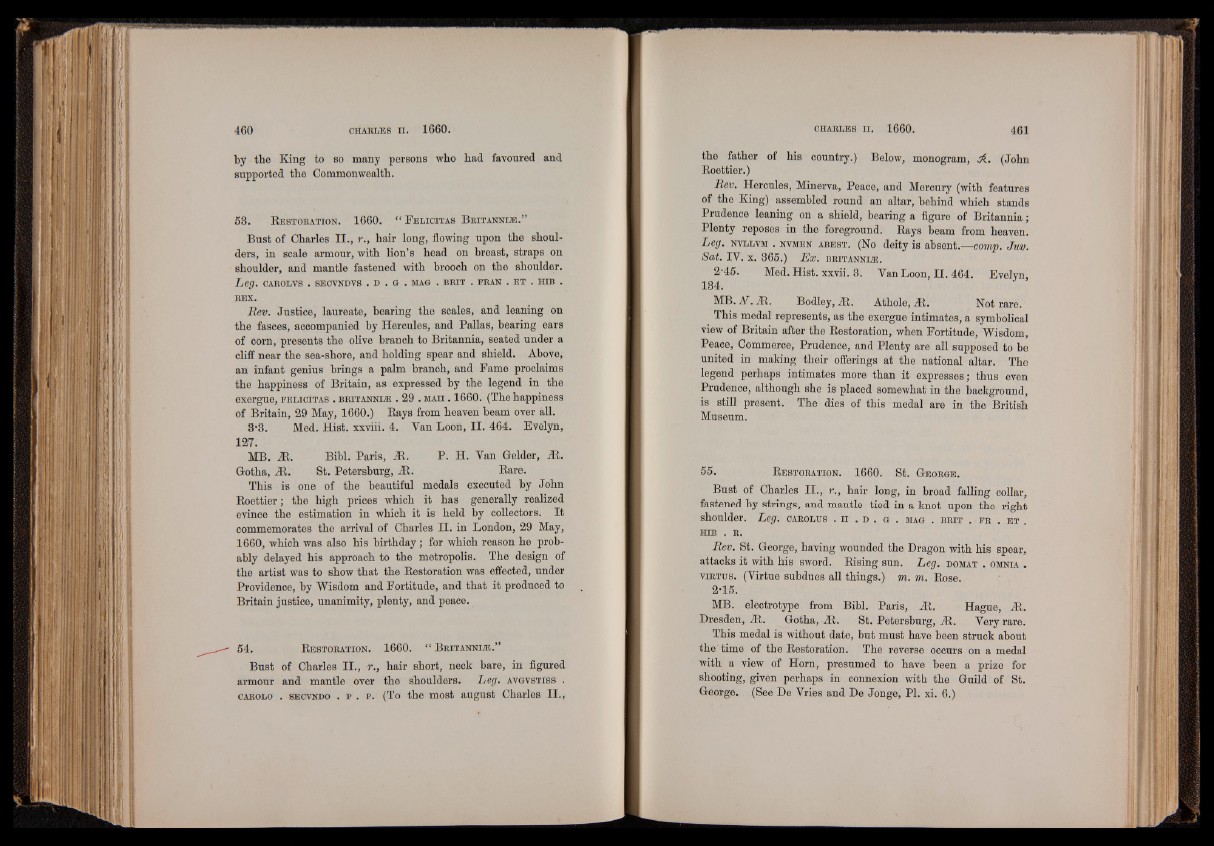
by the King to so many persons who bad favoured and
supported the Commonwealth.
58. R e s t o r a t io n . 1660. “ F e l io it a s B rita n n ia ? .”
Bust of Charles II., r., hair long, flowing upon the shoulders,
in scale armour, with lion’s head on breast, straps on
shoulder, and mantle fastened with brooch on the shoulder.
Leg. carolvs . seovndvs . d . g . mag . b r it . era n . e t . h ib .
REX.
Rev. Justice, laureate, bearing the scales, and leaning on
the fasces, accompanied by Hercules, and Pallas, bearing ears
of corn, presents the olive branch to Britannia, seated under a
cliff near the sea-shore, and holding spear and shield. Above,
an infant genius brings a palm branch, and Fame proclaims
the happiness of Britain, as expressed by the legend in the
exergue, f e l ic it a s . b r it a n n l e . 29 . m a ii . 1660. (The happiness
of Britain, 29 May, 1660.) Rays from heaven beam over all.
8-8. Med. Hist, xxviii. 4. Van Loon, II. 464. Evelyn,
127.M
B. At. Bibl. Paris, At. P. H. Van Gelder, At.
Gotha, At. St. Petersburg, At. Rare.
This is one of the beautiful medals executed by John
Roettier; the high prices which it has generally realized
evince the estimation in which it is held by collectors. It
commemorates the arrival of Charles II. in London, 29 May,
1660, which was also his birthday; for which reason he probably
delayed his approach to the metropolis. The design of
the artist was to show that the Restoration was effected, under
Providence, by Wisdom and Fortitude, and that it produced to
Britain justice, unanimity, plenty, and peace.
54. R e s t o r a t io n . 1660. “ B r it a n n ie . ”
Bust of Charles II., r., hair short, neck bare, in figured
armour and mantle over the shoulders. Leg. a v g v st is s .
carolo . secvndo . p . p . (To the most august Charles II.,
the father of his country.) Below, monogram, £ . (John
Roettier.)
Rev. Hercules, Minerva, Peace, and Mercury (with features
of the King) assembled round an altar, behind which stands
Prudence leaning on a shield, bearing a figure of Britannia;
Plenty reposes in the foreground. Rays beam from heaven.
Leg. nvllvm . n vmen a b e s t . (No deity is absent.— comp. Juv.
Sat. IV. x. 865.) Ex. b r it a n n ie .
2-45. Med. Hist. xxvii. 8. Van Loon, II. 464. Evelyn,
184.
MB. N . At. Bodley, At. Athole, At. Not rare.
This medal represents, as the exergue intimates, a symbolical
view of Britain after the Restoration, when Fortitude, Wisdom,
Peace, Commerce, Prudence, and Plenty are all supposed to be
united in making their offerings at the national altar. The
legend perhaps intimates more than it expresses; thus even
Prudence, although she is placed somewhat in the background,
is still present. The dies of this medal are in the British
Museum.
55- R e s to r a t io n . 1660. St. G e o r g e .
Bust of Charles II., r., hair long, in broad falling collar,
fastened by strings, and mantle tied in a knot upon the right
shoulder. Leg. carolus . i i . d . g . mag . b r it . f r . e t .
h ib . R.
Rev. St. George, having wounded the Dragon with his spear,
attacks it with his sword. Rising sun. Leg. domat . omnia .
v ir t u s . (Virtue subdues all things.) m. m. Rose.
2-15.
MB. electrotype from Bibl. Paris, At. Hague, At.
Dresden, At. Gotha, At. St. Petersburg, At. Very rare.
This medal is without date, but must have been struck about
the time of the Restoration. The reverse occurs on a medal
with a view of Horn, presumed to have been a prize for
shooting, given perhaps in connexion with the Guild of St.
George. (See De Vries and De Jonge, PI. xi. 6.)